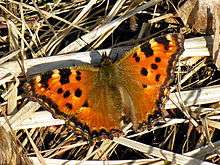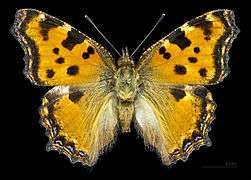Large tortoiseshell
| Nymphalis polychloros Large tortoiseshell | |
|---|---|
 | |
| Scientific classification | |
| Kingdom: | Animalia |
| Phylum: | Arthropoda |
| Class: | Insecta |
| Order: | Lepidoptera |
| Family: | Nymphalidae |
| Tribe: | Nymphalini |
| Genus: | Nymphalis |
| Species: | N. polychloros |
| Binomial name | |
| Nymphalis polychloros (Linnaeus, 1758) | |
| Subspecies | |
| |
| Synonyms | |
The blackleg tortoiseshell or large tortoiseshell (Nymphalis polychloros) is a butterfly of the family Nymphalidae. Although it looks very like the small tortoiseshell (Nymphalis urticae), it is more closely related to the Camberwell beauty. It is found in Europe, northern Africa, and western Asia.[1] It is an extreme rarity in Britain, although it used to be widespread throughout England and Wales. Most of the specimens seen in Britain are thought to be captive-bred releases.
The adult insect (imago) over-winters in dry dark places, such as hollow trees or out buildings. In late February or early March the butterflies emerge and mate. The females lay their pale green eggs (ova) in a continuous band around the upper twigs of elm (Ulmus spp.), sallow (Salix caprea and Salix viminalis), pear (Pyrus spp.), and Prunus spp. trees.[1] The caterpillars (larvae) are gregarious, and systematically strip the topmost twigs of the tree bare. They seem to have little defence against predation by birds. It is possible that their decline and extinction in the British Isles (late 1970s) was due to the loss of predatory birds, which previously had preyed upon smaller birds if they strayed to the tops of these trees.
 ♂
♂ ♂ △
♂ △
The full grown larva spins a silk girdle around a twig further down the tree, and hangs from this by means of hooks (cremasta) at its rear end, to pupate. The chrysalis (pupa) is greyish-brown with a slight silvery sheen. There is only one generation per year, and the imagos emerging in mid summer seek out sources high in sugar to feed. Tree sap and damaged ripe fruits are particularly suitable sources.
References
| Wikimedia Commons has media related to Nymphalis polychloros. |
- 1 2 3 Nymphalis polychloros, funet.fi